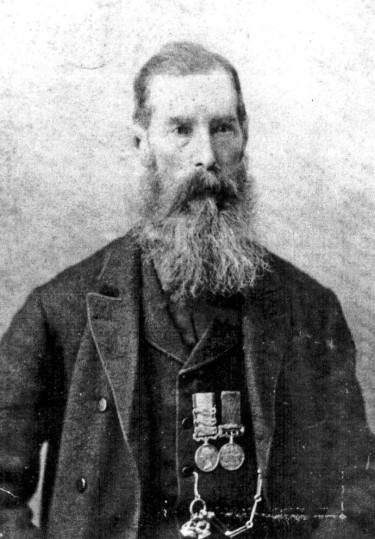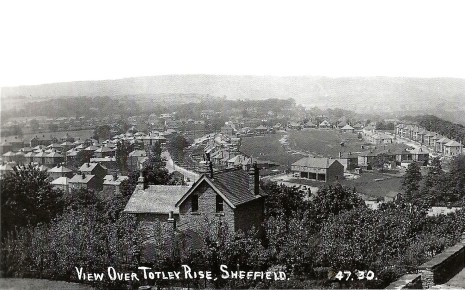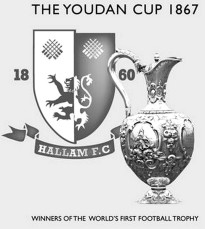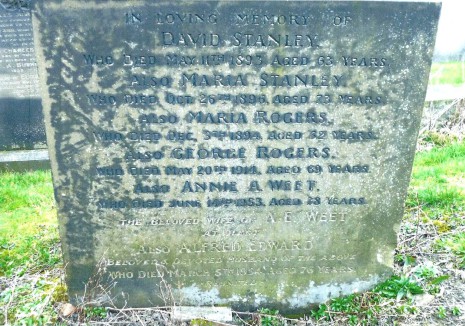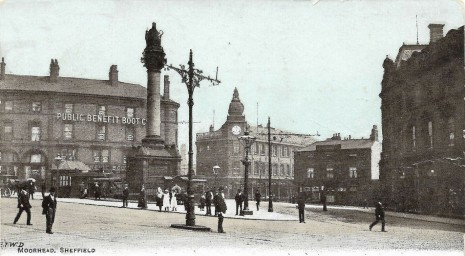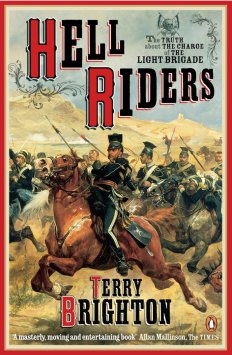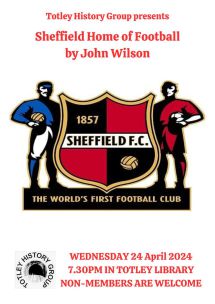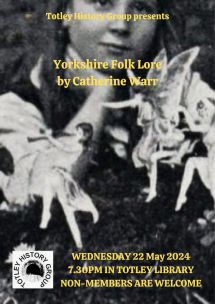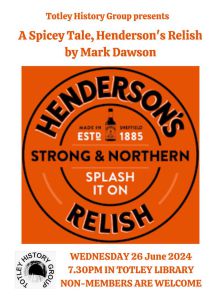David Stanley - Totley Charger
This imposing looking gent is David Stanley who lived in Totley in later life but in his twenties he was part of an event which even now has the power to shock us.
He was born on 21 January 1830 in Bulwell, Nottinghamshire, the eighth of ten children of Samuel Stanley, an agricultural labourer, and his wife Sarah Chambers who married on 11 January 1814 at St. Peter, Nottingham. On 10 July 1849, at the age of 19, he enlisted at Nottingham as a Private in the 17th Lancers, a cavalry regiment, giving his occupation as a mason. In 1853, the British Empire became involved in the war being fought over the disintegrating Ottoman Empire. The 17th Lancers joined with four other regiments to create the Light Brigade and in 1854 were sent to the Crimean peninsula.
On 25 October 1854 the battle for Balaclava was underway. Ambiguous orders led to the Light Brigade mounting a charge against Russian forces who far outnumbered them and who were heavily armed with canon. The soldiers of the Light Brigade must have known they had little hope of surviving the battle. Despite this they advanced into the valley with the 17th Lancers riding in the front line. They came under withering fire from all sides. What was left of the Light Brigade engaged the Russians at the end of the valley and forced them back.
Eventually overwhelmed, the Light Brigade retreated back up the valley still under fire. The numbers of men involved in the charge and the casualty figures have been widely misrepresented. There were 673 men on parade on the morning of the Charge but some of those would have later reported sick or been assigned to other duties. There were also a few foreign allies to add on so a figure around 650 is closer to the mark than the "six hundred" made famous by Tennyson's poem. Of these, 395 (60%) returned up the valley unscathed or with minor injuries that were not reported to the surgeons. Remarkably, less than 17% were killed although a number of those taken prisoner were later to die from wounds.
One of those who was seriously wounded and who returned up the valley was David Stanley. In charging the Russian cavalry and attempting to disable and dismount a gun he received a lance wound in the side. When returning he had his horse shot from under him and he was further wounded by the Russian cavalry whilst on foot. Eventually he was able to mount a passing horse and ride back to safety. He was sent with the wounded to the hospital in Scutari and returned to his regiment on 6 November 1854, the day after the Battle of Inkerman.
He was later awarded the Crimean Campaign Medal with clasps for Alma, Balaclava and Sebastopol. The Charge of the Light Brigade is legendary for the courage of the soldiers and the ineptitude of their commanders. The survivors of the Charge were treated as heroes by the public for many years after and it is no surprise then that David Stanley carried his Balaclava history with him in the naming of the places he lived.
David purchased his discharge from the Army on 12 August 1856 for the sum of £20. He moved back to Nottinghamshire becoming a butcher in Mansfield. On 27 January 1857 he married Harriet Walker at St. Barnabas Roman Catholic Church, Nottingham. Harriet was born in 1830, the daughter of John Walker, a cotton spinner, and his wife Anne Swift who married on 2 May 1808 St. Michael, Farnsfield, Nottinghamshire. Sadly Harriet died three years later and was buried at St. Barnabas on 22 June 1860. There were no children from the marriage.
In 1861 David was a milk seller living at 14 Convent Street, Nottingham but by about 1864 he had moved to Sheffield. In the census of 1871 he was running the Balaclava Inn at 43 Wellington Street in the Devonshire Quarter. Living with him was Maria Burnham, the estranged wife of John Burnham, a book agent, who had married on 26 June 1842 at St. Peter, Nottingham. Maria had a daughter, also called Maria, who was baptised at Sneinton on 29 January 1843. John Burnham died in October 1872 in Halifax and in 1877 David married his widow in Leeds.
It appears that David's license to sell beer on or off the premises was issued in error and renewals were only to sell beer off the premises. By 1873 he was described as a grocer and provision dealer. David attended a number of reunion banquets in London, the first of which was held at Alexandra Palace on 25 October 1875 when the survivors were given free rail passes to attend. A few days before it, he was interviewed by the Buxton Herald. That interview is reproduced below.
In the 1881 Census David and Maria were still recorded at 43 Wellington Street which was no longer called Balaclava Inn and David's occupation was shown as a grocer and builder. We know that at some stage he was also the publican at the Sheaf View in Heeley because at the time this article was first written there was a framed display in the pub containing articles about his time in the 17th Lancers and subsequent employment.
By 1886 David and Maria had moved to Totley Rise, living on Queen Victoria Road where it meets Woodland Place in a house they named Balaclava House. On 3 October 1890 David was the guest of honour at the annual dinner and prize-giving of the Dore, Totley and Holmesfield Agricultural and Horticultural Society which was held at Dore School. He replied to a toast given to "a Balaclava hero" by giving an account of the Charge in simple terms saying he was very proud to be one of their number. His remarks were listened to by a large audience with considerable interest and drew loud applause.
David Stanley died at Balaclava House on 11 May 1893, aged 63, and was buried in Norton Cemetery, Derbyshire Lane five days later. The house was put up for sale the following spring together with four semi-detached houses (1-4 Stanley Villas?) and a plot of building land on the opposite side of Queen Victoria Road. Maria went to live with her daughter and her family at 150 St. Mary's Road, Sheffield. She died there on 26 October 1896, aged 72, and was buried with her husband three days later. We do not know when the original Balaclava House was demolished. A block of flats stands on the site today which bears the same name.
August 2012
Revised September 2020
David Stanley - In His Own Words
Thursday 21 October 1875 Buxton Herald (page 3)
The Balaclava Banquet
Story of another Sheffield man who was in the Charge
David Stanley, of 43 Wellington street, says: - I was in the charge of the Light Brigade, and Lord Cardigan was in the front of our regiment when Captain Nolan brought the order. He told Cardigan he was to charge and take the guns. He was asked "What guns." He says, "There's the guns, my lord, and here's the order. You're to charge and take them." Cardigan threw his sword in the air, and said, "Here goes the last of the Cardigans." Nolan said he would go with him. We were all very much excited, but started without delay. The first order was, as I understood it, after we started in the charge, "Three's right," which was taken to mean that we must take the guns on the right. In a moment afterwards we were ordered to "Front and forward," and that moment Captain Nolan was shot dead.
I rode right to the Russian cavalry. Sergeant Talbot rode next to me in the front rank. When we were half way down he had his head blown off, and he rode sixty yards in the saddle before he fell. Corporal Hall, who rode on my other side, had his leg blown off and his horse was shot. He fell and was taken prisoner, and died a prisoner. I was left alone once because of all the men being blown to death around me and I had some difficulty in regaining my regiment. I rode right up to the Russian cavalry, and assisted in driving them back until we got into the centre of them. They tried to surround us. We went threes about, came back, met the second line, fronted, and drove them again. Then we left the battery that played upon us in our front. We shot one of the horses in the shaft of the front gun. we beheaded some of the men of the battery, and ran others through with our lances, and dismounted every one of them. It was a cold-blooded affair, and that's certain; but we were forced to do it, or they would have blown every man of us to pieces. After that we retreated. We didn't spike the guns; because we hadn't any, and if we had had spikes we couldn't have used them, because we had not time. It took us all our time to look after ourselves.
I was wounded at the guns - a lance in my right side; it was only a flesh wound. On returning I had my horse shot from under me. The Russian Lancers were forming line in front of us as we were retreating, and we cut our way through them the best way we could. Their own infantry and artillery opened a volley of fire upon us all, Russians and English, and shot at any of us. As far as thins goes, it was just the same as shooting dogs. There were four of us together, who had our horses shot under us - one got on the ground, and could not get up. Three Russian cavalry rode down to him, took his carbine from his side, and put it to his hair,and of course I thought he was going to blow his head off, but he lay down on the ground and they left him. He was severely wounded. I stood there and saw the sight. They left him and rode down to me, and they muttered something to me, but I could not tell what it was. I whipped my sword belts undone, took hold of by scabbard, in self-defence. All three of the swords came clash on to me at once - one of them cut through my epaulette, shoulder knot and jacket, and another cut three-eighths of an inch into my sword scabbard, and I thought that if one of them offered to make a point at me as the others were cutting at me, I should be a done man, so I fell on my back on the ground, and they went away and left me for dead. As soon as they rode away I was on my feet again.
I felt I was all right when they went away. In about a minute afterwards there were five horses came galloping up all in a line. I stopped one of those, the nearest to me, and mounted it, and the saddler-sergeant of the regiment, named Scarf, tried to do the same, but his hands were scored the same as you would score a piece of pork, and they were useless, and he couldn't stop the horse, and his head was cut to a mummy nearly. A moment afterwards the remains of the 11th Hussars came riding up and they had a few spare horses with them, and they said "What's those in front of you, my lads; are they the 17th, or are they the enemy?" I said, "They are the enemy." They mounted Sergeant Scarf. I don't know whether he died or not. We got in front of these two regiments, 11th Lancers and 12th Hussars, and we broke them the best way we could. Then we rode back again to our lines, and had to keep turning out of our way for the dead and the wounded, and when we got back we were cheered by the remains of our comrades. When we got back Lord Cardigan, who looked as if he was nearly dead, poor fellow, raised his sword, and said, "O my poor Light Brigade, they're all murdered."
I was sent with the wounded to Scutari. Captain Webb died there of his wounds, and I helped to bury him in Scutari. We were sent back to the regiment the day after Inkerman was fought. That candlestick on my table I took from Count Worresoff sixteen miles from Balaclava. He made his escape and each man was allowed to take a trophy. We enjoyed ourselves in his house very well, and brought some champagne home at night. I am going to send the candlestick to Alexandra museum. They say they'll be very glad to have it. One of our chaps, named Andrew Styne, had seventeen lance wounds in him after he lost his horse. The Cossacks kept pricking at him with their lances as they rode past. He survived all his wounds. I have not met any of my comrades except Dickenson since I left my regiment, so you may well suppose I shall be glad to meet them at the banquet on Monday. The night before the charge there were fourteen and fifteen men in a tent; but the next night there only two and three in a rent and in some tents only one.
Memories of Balaclava House
Our article about David Stanley, the veteran of the Charge of the Light Brigade during the Crimean War, who lived the last years of his life in Totley and died here in Balaclava House on Queen Victoria Road, prompted Richard Tetley to get in touch and tell me his memories of the house and area.
During his childhood Richard lived at Oakwood (no.60); the house stands next door to the site of the old Balaclava House. The Dingle was the old house's other neighbour up the hill. When Richard lived at Oakwood the garden of Balaclava House was very overgrown. The owner, Mr Vickers-Edwards was rather reclusive and the house was a bit of a mystery. There was an orchard at the back of the houses on the land now occupied by Prospect Drive, and beyond that the fields up to Tinker's Corner were owned by Tedbar Tinker. Richard remembers the old house was still there when he moved away from the area in the early 70's, but thinks that it was demolished when Mr Vickers-Edwards died shortly after.
There is a possibility that Balaclava House is in the foreground of the picture on page 14 of Brian Edward's Totley in Old Photographs. The plot the old house stood on was extensive; far larger than the area now occupied by the flats and grounds of the present day Balaclava House. I had thought the old house was built further down Queen Victoria Road, so it was interesting to walk around the area with Richard as he remembered how it was and good to see that the name has survived the demolition of the old house.
The Totley connection with the Crimean War goes beyond David Stanley and Balaclava House. Another famous Totley resident was Tommy Youdan. In a trade journal of 1868, he is recorded as living in Totley Grove House. Youdan was a well-known Sheffield character and a bit of a lad! He converted his casino into the Surrey Street Music Hall in 1852 (it burnt down in 1865 after an extravagant production involving fire and explosions on stage); he also inspired the first association football competition with the Youdan Cup. The first match for the cup was played at the Sheffield Hallam ground; now Sheffield United.
The Crimean War ended in 1856 and in celebration Tommy Youdan asked the confectioner George Bassett to bake a cake. The cake was so huge (it weighed 4 tons) it had to be carried through the town on wagons three abreast. In total over 10,000 eggs were used, 2,000 pounds of flour, 1,300 pounds of butter, 3,400 pounds of currants and raisins. The icing alone weighed 412 pounds. There were complaints it was not properly cooked and Youdan's plans to sell tickets for a lottery of slices which contained medals was declared an illegal lottery by the Government.
* Alma and Balaclava were the most well know events and places in the Crimea and are commemorated in street and pub names all over Sheffield.
The details about Tommy Youdan's cake are taken from the Crimean War Research Guide produced by Sheffield Archives and Local Studies Library..
Christine Shimell
September 2012
David Stanley's Grave
We are grateful to Marlene Marshall who has sent us this photograph of the insciption on David Stanley's grave in Norton Cemetery.
The inscription reads:
IN LOVING MEMORY OF
DAVID STANLEY,
WHO DIED MAY 11TH 1893, AGED 63 YEARS.
ALSO MARIA STANLEY.
WHO DIED OCT 26TH 1896, AGED 73 YEARS.
ALSO MARIA ROGERS,
WHO DIED DEC 5TH 1894, AGED 52 YEARS.
ALSO GEORGE ROGERS,
WHO DIED MAY 20TH 1914, AGED 69 YEARS.
ALSO ANNIE A. WEET,
WHO DIED JUNE 14TH 1953, AGED 78 YEARS,
THE BELOVED WIFE OF A.E. WEET.
AT REST
ALSO ALFRED EDWARD,
BELOVED & DEVOTED HUSBAND OF THE ABOVE
WHO DIED MARCH 5TH 1954, AGED 76 YEARS.
REUNITED
April 2015
Light Brigade Locals
Records show that Private David Stanley (a Nottingham man) rode with the 17th Lancers in the Charge (and was wounded). He was apparently a mason prior to enlistment in the Army on 10 July 1849. He purchased his discharge from the Army on 12 August 1856 for the sum of £20. Incidentally, if indeed, Stanley lived locally, he was not the sole participant in that historic event to have links with Sheffield. At least one other, Sergeant Francis Dickinson (curiously also of the 17th Lancers - whose usual recruiting area was Nottinghamshire/Leicestershire) lived at 20 Tillotson Road, Heeley in the 1890's. I believe also that the uniform jacket of Sergeant Major George Loy Smith, 11th Hussars was (and may still be) in the care of Kelham Island Industrial Museum. For those interested some 658 men participated in the Charge and 287 became casualties. Interesting displays of military items and medals relating to the Charge may be seen in museums at Cannon Hall, Barnsley and Belvoir Castle, Leicestershire.
S E Acaster
Society for Army Historical Research
Military Society
September 1999
David Stanley and the Charge of the Light Brigade
I no longer live in the area but enjoy ‘keeping tabs’ on the old place where I lived for over 30 years. My military studies and research continue unabated although much further North in The County but still include a continuing a 'watching brief' on Totley’s own military heritage which appears to go from strength to strength with interest and input, much stronger than when I left the village some five years ago.
On this occasion, I write specifically to the very interesting contribution regarding the old ‘Light Brigade Charger’ David Stanley, once a resident in the area, which should and I hope still does, create interest in at least some of those who read and contribute to, Totley’s excellent, ‘all aspects’ site. It is due to that prospect that I feel obliged to seek to correct a widely held/understood belief, quoted in the contribution, on the experience of The Light Brigade of 25th October 1854.
That concerns the casualty numbers for that infamous engagement of The Crimean War. I think its now generally agreed by experts that The Brigade fielded something in the region of 650 mounted men (which included individuals, not part of the five regiments principally concerned but such personalities as two French/Sardinian liaison officers). Depending on what those with interest in the action have heard /believed over the years - including I’m afraid purely ‘artistic’ accounts, with nonsensical assertions that numbers as low as zero, failed to ride back to the by then, incredulous, horrified, British lines. Well, not only is that assertion untrue but, also, I'm afraid so is the often re-quoted figure of ‘less than 200’.
Any single casualty of war is bad but those who plan and actually coordinate these things, had to and still have to, expect that a proportion of men and these days, women WILL die, be injured or taken prisoner by the enemy. All of these categories are regarded as ‘casualties’. In so far as the cavalry action at Balaklava on that day, is concerned, the modern calculations indicate that of the 650 or so who attacked the Russian gun lines, a figure just short of 400 came out and returned to the British position with only minor injuries, if any at all - some 60%! Startlingly ‘only’ 17% of human casualties proving fatal. Quite different from the public perception of over a century and a half!
That is NOT to suggest that The Charge, or indeed any other engagement in war in any period was an ‘picnic’ - of course not and the horrific details of what cannon fire did to the bodies of men and horses is well recorded in that and other wars, including WW1. On that last aspect, as was almost invariably the case, the animal casualties were atrocious - quoted as approaching 400 Light Brigade horses killed on the field of Balaklava or by euthanasia afterwards.
Any reader of your site with more than a passing interest in the subject, would do worse than obtain a copy of the very well written and eminently readable book, Hell Riders published some years ago and authored by a keen academic and member of The Queens Royal Lancers curatorial staff, Terry Brighton. The book addresses all key aspects of the battle including the fascinating circumstances of the Brigade Commander and much reviled, Lord Cardigan’s apparent, untimely departure from the field. All was not as it seemed!
Incidentally, the Museum of The Queens Royal Lancers, the successors of the 17 Lancers, David Stanley’s regiment, is located a reasonable and pleasant drive from Totley, in the grounds of Thoresby Hall, Nottinghamshire near Ollerton. In a lovely, scenic spot, it’s well worth a visit.
Stephen Acaster
North Yorkshire
September 2020
Search Our Website Here
Future Meetings
April
May
June
Unless stated otherwise our meetings are held in Totley Library on the 4th Wednesday of each month at 7.30pm.
Pauline Burnett's book The Rise of Totley Rise has been revised and updated. It tells the story of this small piece of land from 1875 when there was only a rolling mill and chemical yard alongside the river a mile from Totley, through Victorian and Edwardian times, two world wars and up to the present day. It has 94 pages including a useful index and many illustrations from private collections. The book is available now from Totley Rise Post Office priced at £5, or through our website when an additional charge will be made to cover packing and postage.
A few copies are still available of Sally Goldsmith's book Thirteen Acres: John Ruskin and the Totley Communists. Totley was the site of a utopian scheme funded by art critic and social reformer John Ruskin. In 1877 he bought 13-acre St. George’s Farm so that nine Sheffield working men and their families could work the land and, to keep themselves busy, make boots and shoes. Sally tells an engaging story from our history with a quirky cast of characters including Ruskin himself, the poet and gay rights activist Edward Carpenter and Henry Swan, a cycling, vegetarian artist and Quaker. The book is available to order online from the The Guild of St. George by following this link.
A recently discovered box of WWII correspondence reveals the story of how a small group of ladies from Dore and Totley recruited knitters from the west of Sheffield and how their efforts made them the country's greatest provider of Comforts for the Minesweeping crews of the Royal Navy. The story is told in Knit For Victory, a new book from Totley History Group. Written by Pauline Burnett, it has 82 pages and many illustrations. It is on sale in local shops and via our website. Further information about the correspondence is in this inside page of our website: Dore & Totley Minesweeping Trawlers Comforts Fund.
The story is told in Totley War Memorial WW1 of the ten men from our village who gave their lives in the Great War. Written by Pauline Burnett, Jim Martin and Dorothy Prosser, a chapter is devoted to each of the soldiers with a family tree followed by as much information as could be discovered about the men and their families. There is also information about their military careers and the actions in which they lost their lives. The book has 64 pages and is illustrated throughout with photographs of the men, their families and the houses where they lived.
Totley All Saints' Church Parish Magazines for the years 1985-2006 with notices of baptisms, marriages and funerals and accounts of spiritual, educational, charitable and social matters in the village. Scanned in full, including advertisements from local traders.
In 1893 during the building of the Totley Tunnel there was an outbreak of smallpox amongst the navvies which spread to some of the local population. 17 people were buried in communal graves in Dore Churchyard, 6 from "Green Oak" (Lemont Road). The severity of the outbreak was principally caused by overcrowding and insanitary conditions in lodging houses .
Kathleen Grayson was a 39 year old housewife when WW2 broke out. She volunteered for the ARP and became an ambulance driver. During an air raid on Sheffield in July 1941, and despite her own injuries, she managed to get a seriously injured casualty to hospital. For this she was awarded a commendation from King George VI. Together with her friend Hilda Duffy, Kathleen also assembled a team of knitters to provide essential warm clothing for the men serving on the minesweepers patrolling the North Sea.
We have recently bought at auction the WW2 memorabilia of Douglas Platts whose family home was at Hillside, 98 Queen Victoria Road. After the war Douglas returned to his civilian occupation working in the family scissors manufacturing business. He lived in our area for the rest of his life.
We are very grateful to Mrs Valerie Taylor of Dore for lending us the title deeds to Lower Bents Farmhouse which is reputed to be the oldest surviving building in the area with a proven history back to 1621. We have now scanned and transcribed the deeds which could be particularly interesting to anyone with a connection to the local Fisher, Dalton and Marshall Families.
Until 1844, when Dore Christ Church parish was created, Totley township was part of Dronfield parish. We have now transcribed the burial records for former Totley residents at St. John the Baptist, Dronfield for the period 1678-1870 and at St. Swithin, Holmesfield for the period 1766-1901.
Whilst researching the history of the Dalton Family we found it useful to transcribe a number of early Wills and Inventories. These and those of many other Totley, Dore and Holmesfield people dating from between 1594 and 1856 have now been added to our website.
St. Swithin's Church, Holmesfield pre-dates Dore Christ Church and was the place where many of the people from Totley worshipped and were baptised, married and buried. Read the inscriptions on more than 750 gravestones in the churchyard including those of Mr. and Mrs. William Aldam Milner of Totley Hall, Jessie Matilda Tyzack (nee Fisher) of Avenue Farm, and Rev. J. A. Kerfoot of St. John's, Abbeydale.
Thomas Youdan was a music hall proprietor and benefactor who was living at Grove House, Totley in 1867 when he sponsored the first football knockout competition in the world for The Youdan Cup.
The words Millhouses Cricket Club can be seen in the background of team photos which are likely to date from between 1905 and the early 1920s, very probably pre-war. They were lent to us by Garth Inman who can identify his great uncle, Cecil Inman, in some of the photos and would like to know when they were taken and, if possible, the names of others present. Please take a look to see whether you can put names to any of the faces.
Josiah Hibberd was seriously injured whilst working on the construction of the Totley Tunnel in 1892. He died on 9 May 1897 at the age of 38 having apparently spent most of previous five years in hospital.
Bradway House was built around 1832 by Henry Greaves, a farmer, together with two adjacent cottages. We have traced most of the occupants of the property from these early days up to the start of World War Two.
We have transcribed the baptisms records at St. John the Evangelist, Abbeydale from when the church was consecrated in 1876 until just after the start of World War 1. The records are arranged in alphabetical order based upon the child's name and show the date of baptism, the names of the parents, their home location and occupation.
Nick Kuhn bought an original 1920s poster which had this owners' blind stamp in one corner. The stamp almost certainly refers to a house named Wigmore that was built in the late 1920s or early 1930s. The first occupiers that we can trace are John Howarth Caine, a district mineral agent for the LNER, his wife Florence Jane (nee Prince) and daughter Doris Mary. The Caine family lived at Wigmore until 1936 by which time the house would have been known simply as 12 The Quandrant.
George Griffiths died on 13 December 1888 following an explosion during the sinking of number 3 airshaft at Totley Bents. His widow Florence died shortly afterwards and his two daughters Maud and Annie were adopted separately. Whilst Annie lived the rest of her life in Yorkshire, Maud emigrated to Australia in 1923 with her husband, John Burrows, daughter Margaret and son Jack, pictured above.
George Wainwright was said to have been born in Bamford, Derbyshire in 1714. He learned the trade of linen weaving and moved to Totley after his marriage on 1744. He became an ardent follower of John Wesley who paid many visits to Sheffield and who would have passed through or close to Totley. Preaching was at first conducted out of doors and when Wesley's preachers became harassed by a mob of Totley ruffians in 1760, George offered them safety of his own home. He remained a Methodist for all of his long life, dying in Dore in 1821 at the reputed age of 107.
Oakwood School was started by Mrs Phoebe Holroyd in 1925 initially as the Firth Park Kindergarten and, by 1927, as the Firth Park Preparatory School. Phoebe was still working at the school almost fifty years later when she was well into her seventies. We would like to hear from anyone with memories of the school.
James Curtis was born at sea aboard HMS Chichester in 1790. He enlisted as a Private in the 1st Grenadier Regiment of Foot Guards in Sheffield in 1812 and served in Spain and Portugal during the Peninsular War. He later fought in France and Belgium taking part in the Battle of Waterloo. In later life James lived at the Cricket Inn where his son-in-law William Anthony was the licensed victualler. He died in Heeley in 1882 aged about 91.
Charles Paul lived in Totley in later life. He was a local historian and archaeologist who was an authority on the history of Sheffield, especially the two areas he knew best: Attercliffe and Ecclesall. His books and letters to local newspapers were published under the Latin form of his name Carolus Paulus.
Towards the end of the 19th century Totley Hall gardens became a well known beauty spot that attracted many hundreds of visitors from Sheffield on open days and the rock gardens became one of its most popular features. Mrs Annie Charlesworth sent us six glass transparencies of the rock gardens taken, we believe, in the early years following the Great War.
Anton Rodgers send us photographs of three water-colours that had been bought by his grandfather at a sale of the contents of Abbeydale Hall in 1919. One was of a scene said to be in York by A. Wilson. A second was of a seated child with a dog believed to be pianted by Juliana Russell (1841-1898). The third was of Lake Como, by Ainslie Hodson Bean (1851-1918) who lived for much of his life on the Riviera and in North Italy.
A Canadian correspondent sent us photographs of a set of silver spoons that were bought in a small town in British Columbia. The case contained a note signed by Ebenezer Hall indicating that they were a wedding gift to Maurice and Fanny Housley. We think we may have traced how they got to Canada and where they might have been since.
Green Oak Park was opened on 23 March 1929 on land that had been bought by Norton District Council from John Thomas Carr, a farmer and smallholder of Mona Villas. In later years, the buildings were used by the Bowling Club (the green having been built in 1956) and by the park keeper. However, the buildings appear to have been constructed in several phases, the oldest of which predates the park to the time when the land was used for pasture.
We believe the old Totley Police Station at 331 Baslow Road was built around 1882. Two lock-up cells were excavated just below floor level in the summer of 1890. We have traced the Derbyshire Constabulary police officers who lived there from John Burford in 1886 to George Thomas Wood who was there when Totley was absorbed into Sheffield in 1934.
David Stanley lived in Totley Rise in the later years of his life. Born in Bulwell, Nottinghamshire, he joined the 17th Lancers when he was 19 and rode in the Charge of The Light Brigade at the Battle of Balaclava where he was seriously wounded. For the first reunion of veterans in 1875, he told his story to a reporter from the Buxton Herald.
This picture postcard was addressed to Miss Abell, Holly Dene, Totley Brook Road and posted in Rotherham on 10 December 1907. Edith Annie Abell was born on 4 February 1887 in Sheffield and her family came to live in our area in the 1900s, staying for the rest of their lives.
Charles Herbert Nunn enlisted in the British Army on 23 August 1915 and was sent to France on 18 December 1915 to served with the British Expeditionary Force. In March 1916 it was discovered that he was underage and he was returned home. Shortly after his 18th birthday he re-enlisted and was again posted abroad where, in addition to this trio of medals, he was awarded the Military Medal.
This certificate was awarded jointly by the Red Cross and St. John's Ambulance to Isaac Henry Williams, of Lemont Road, for his services during WW1 as a stretcher bearer. We are seeking anyone who can help us pass it on to a living relative.
In 1832 Samuel Dean pleaded guilty to stealing a quantity of lead from the Totley Rolling Mill and was sentenced to seven years transportation to Australia. He sailed on the Mangles and upon arrival in New South Wales he was sent to work for William Cox, the famous English explorer and pioneer. After receiving his Certificate of Freedom in 1840, Samuel became a farmer and went on to have a very large family. Samuel was born in Whitechapel around 1811 to parents Samuel Dean Snr. and Susannah Duck. His descendant Sarah Dean would like help in tracing his ancestry.
Ellen Topham was born in 1889 in Nottingham. Her parents had been living together since 1862 but had never married so it was most unusual that, after their deaths, Ellen was accepted into Cherrytree Orphanage. Even more so since her father, Snowden Topham, had been acquitted somewhat unexpectedly in a widely reported manslaughter trial. Ellen remained at Cherrytree until her death from pulmonary tuberculosis at the age of 15.
Mabel Wilkes was a resident in Cherrytree Orphanage between 1897 and 1905. Her granddaughter Sally Knights sent us these images of a book presented to Mabel as a prize for her writing. Sally also sent us some personal memories of her grandmother and a photograph of a locket which contains portraits of Mabel and her husband Septimus Gale.
John Henry Manby Keighley was living at Avenue Farm when he enlisted in 1916. He fought in France with the Cheshire Regiment but after home leave in early 1918 he went missing. The Army were unable to determine whether he had deserted or returned to the front and been either killed or captured by the enemy. In August 1919 he was formally presumed killed in action but it appears he did not die but returned home to his family.
Horace Ford was admitted to Cherrytree Orphanage on 26 October 1888 at the age of six. He left at the age of 14 to become an apprentice blacksmith and farrier. Soon after his 18th birthday Horace enlisted in the Imperial Yeomanry to serve his country in the war in South Africa. His letter home to his Orphanage mentor tells of the lucky escape he had in battle.
Pat Skidmore (née Sampy) lived on Totley Brook Road from 1932 to 1948 before her family moved to Main Avenue. In this short article she remembers her time at Totley All Saints School where she was a contemporary of Eric Renshaw and Bob Carr.
As we have nowhere to exhibit memorabilia and artifacts, we have created a Virtual Museum instead. The latest addition to our collection is this double-sided Totley Rise Post Office oval illuminated sign which was on the wall of 67 Baslow Road before the Post Office business transferred to number 71. Please contact us by email if you have things that you own and would like to see added to the virtual museum.
Conway Plumbe was a man of many talents who came to live in Totley Rise around 1912. As a young man he had poems published by Punch magazine and is remembered in modern collections of WW1 poetry. A number of his paintings were accepted by the Royal Academy. An engineering graduate of London University, he joined the Civil Service where he rose to a high level as a factory inspector, publishing two books on the subject and giving a series of talks on workplace health and safety on BBC radio during WW2. In retirement he wrote a philosophical-spiritual work called Release From Time.
Inside Totley Rise Methodist Church there is a Roll of Honour commemorating the soldiers from its congregation who served their king and country during the Great War. For all but one of the 28 names the soldier's regiment is recorded in the next column. The exception is David Cockshott for whom 'killed in action' is written alongside yet he appears on no war memorial in our area and no record of a mortally wounded soldier of that name is to be found. We think we have solved the mystery.
Mrs. Kate Plumbe moved from Mansfield to Totley Rise with a number of her family in 1913 and became closely involved with the Totley Union Church. Her daughter Winifred became a missionary and headmistress in Calcutta for over 38 years following which she returned home to live with her sister Hilda on Furniss Avenue. Hilda had also been a teacher, missionary and, like her mother, a volunteer at St. John's VAD during WW1.
Thomas Glossop was a cutler and razor manufacturer who was well known amongst cricketing and gardening circles. Despite going blind, he was able to continue his hobbies with remarkable success
The Totley Union Cycling Society Prize Giving and Fete was held on the fields near Abbeydale Hall on 18 July 1914. Anne Rafferty and Gordon Wainwright have named some of the people in two wonderful photographs of the event. Can you identify any more for us?
The Tyzack family are well known in our area for owning iron and steel trades at Walk Mill, Abbeydale Works, Totley Rolling Mill and Totley Forge. This article covers the history of the family from the late 18th century when William Tyzack the founder of the company was born until the early 20th century when Joshua Tyzack farmed at Avenue Farm, Dore.
Walter Waller Marrison moved to Totley around 1897 with his wife and their two young sons. He was a house builder who constructed properties around Totley Brook and Greenoak before ill health forced him to take up less physically demanding work. In 1904 he took over the tenancy of the grocers and off licence at number 71 Baslow Road. After his death in 1908, his widow Kate and later their eldest son Jack continued to run the business until it was sold in 1934.
Ron Wijk of Nieuw-Vennep in the Netherlands has sent us two scanned images of drawings of old cottages made by the celebrated Dutch painter, Anton Pieck (1895-1987) simply annotated "Totley", and wondered whether we could identify their locations.
We would like to thank Christopher Rodgers for bringing to our attention this fascinating log of the 85th Sheffield (St. John's and Totley Orphanage) Wolf Cub Pack for 1927-45. The log is published jointly by Sheffield Scout Archives and Totley History Group as a free PDF download. It is illustrated by no fewer than 92 photographs and is supported by a comprehensive index and biographies of some of the main participants.
Following our Open Meeting event on School Days, Roger Hart, Howard Adams and John Timperley have each written to us with their memories of Norwood School, which was located in the rooms attached to the Dore & Totley United Reformed Church on Totley Brook Road.
On 22nd July 1909 the children of Dore and Totley Schools celebrated by a pageant the union of England under King Ecgbert which took place at Dore in AD 827. The pageant was devised and written by Mrs Sarah Milner and her daughter Marjorie and performed in a field close to Avenue Farm in front of a large audience. Photographs of the event survive together with a fragment of the script.
John Edward Greenwood Pinder had lived all 46 years of his life in Totley but on census night, Sunday 2 April 1911, he was not at home; he was in Derby Gaol serving a sentence of three months hard labour. From the age of 20, John had been in and out of local courts for a series of minor offences including drunkenness, assault, wilful damage and night poaching. Finally he was sent to gaol for cutting down and stealing 86 small trees which he sold in Sheffield market for Christmas.
We have already transcribed the census returns for Totley, Totley Rise and Dore. Now we have transcribed Census Strays. These are people who were born in Totley but are missing from our earlier transcriptions. They may have been living, working or studying elsewhere or just away from home on the night the census was taken. Two people were in prison. Others were in Union Workhouses, hospitals and asylums. Fully indexed strays from the 1851, 1861, 1881, 1891, 1901 and 1911 censuses are available now.
We wish to thank Gillian Walker for allowing us to digitize an archive of material about the 1st Totley Scout Group. Most of the material was collected by Arthur Percival Birley in the period 1949-51 and there are many interesting documents pertaining to the building of the scout hut on Totley Hall Lane. In addition four Newsletters survive, two from the 1940s and two from 1971.
We are grateful to Angela Waite and All Saints' Parish Church for giving us access to baptismal and kindergarten birthday rolls dating from 1926 to 1941. We have transcribed the names, addresses, birthdates and baptismal dates and created an alphabetical index of entries for you to search.
Edmund Sanderson, a Sheffield estate agent, aquired the land on either side of the old drive to Totley Grove in 1874 and divided it into plots for development. He called it the Totley Brook Estate. But before many houses were built, the estate road was severed in two by the building of the Dore & Chinley Railway line. The eastern end of the road became the cul-de-sac we now call Grove Road.
John Roberts was born in Sheffield in 1798. He became a partner in one of the leading silversmiths firms in the city before moving to Abbeydale Park in 1851 and extending the house in Victorian gothic style. He paid for the building of St. John's Church and was believed to dispense more in charity than any other person in the neighbourhood including his protege Ebenezer Hall.
The Coke Family owned the Totley Hall Estate from 1791 to 1881. With the aid of a family tree to guide us, Josie Dunsmore takes us through the story of their tenure.
When the Rev. D'Ewes Coke inherited the Totley Hall Estate in 1791 it had two farms. Josie Dunsmore tells the story of how the two farms were combined under the tenancy of Peter Flint with the aid of field maps drawn by Flint himself and later by the Fairbanks family.
Do you think you recognize this face? More than sixty photographs of the girls and teachers at Hurlfield Grammar School for Girls in the 1940s were given to Totley History Group by Avril Critchley, who was herself a student at the school. The collection includes fifteen form photographs from June 1949. There would have been a number of girls from the Totley area attending the school in those days.
Christine Weaving tells the story of her 2 x great uncle George Edward Hukin, a Totley razor-grinder, and his life-long friendship with the academic, poet, writer, and free-thinker Edward Carpenter.
Eric Renshaw (pictured here on the right with Bob Carr) grew up and lived in Totley from 1932 to 1960. Many of his memories are of a sporting nature.
We are very grateful to Gordon Grayson for giving us this splendid sale document for the Norton Hall Estates, following the death in 1850 of Samuel Shore. The estates included a large part of Totley and the document has maps and illustrations, plus schedules of land and property with the names of tenants. We have also added a transcription of the entries for Totley and Dore.
Watch this Youtube video of the talk given by Dr. Mark Frost and Sally Goldsmith on Ruskin, Totley and St. George's Farm. The talk was hosted by Totley History Group on 20th May 2015 as part of the Ruskin in Sheffield programme. Also enjoy a video of the outdoor performance Boots, Fresh Air & Ginger Beer written by Sally.
When Jacqueline A. Gibbons became interested in what made her father tick, it began a journey through WW1 archive records and led to her flying from Toronto to visit the house and village where he lived and the countryside that he so much enjoyed. Jacqueline reminds us that in the early 20th century Sheffield was a driving force of industry and that Totley was the place where many of its remarkable people lived and where they formulated their ideas.
Edgar Wood was the designer of The Dingle, 172 Prospect Road, built in 1904 for Rev. William Blackshaw, the founder of the Croft House Settlement. The house, together with its western terrace and boundary walls, has now been awarded Grade II listed building status.
What was probably "the most perfect little garden railway in existence" in 1910 was to be found in the grounds of Brook House, Grove Road, the home of its designer and constructor, Guy Mitchell. Look at some wonderful photographs and read reports in newspapers and a full appreciation in Model Railways magazine.
We have now completed our transcription of Totley School's Admission Records for the period from 1877 to 1914. There is also a useful index to the names of the scholars and to their parents or guardians. We are very grateful to Sheffield Archives and Local Studies Library for allowing us to transcribe and publish these records and for permission to reproduce the photograph of a specimen page of the register.
On 8, 9 and 11 November 2014 Totley History Group held an exhibition at Dore & Totley United Reformed Church to commemorate the centenary of the First World War. Below are additional links to some of the photographs we were lent and stories we researched especially for the exhibition.
Oscar Creswick was a local farmer who served with the Army Service Corps in Salonika and who after the war returned to Totley to become the innkeeper of the Cricket Inn and a member of the village's successful tug of war team.
Walter Evans was a market gardener who also ran a small grocery shop on Hillfoot Road when war broke out. He fought with the Machine Gun Corps at the fourth battle of Ypres. After the war, Walter ran a grocers shop at the top of Main Avenue.
Fred Cartwright was another Totley soldier who survived the Great War. He fought in France and Belgium and although he wasn't wounded he was gassed and was home on sick leave when his daughter was delivered by Nurse Jessop during a snowstorm in January 1917.
Maurice Johnson joined the Yorkshire Dragoons, a territorial unit, on 1 Jan 1914 and so was called up at the very start of the war. He fought throughout the war on the Somme, at Ypres and at Cambrai. After demobilization in 1919 Maurice returned to his old occupation in the steel industry.
Bill Glossop lent us a letter written by his father, William Walton Glossop to his wife describing life in the army during training in the north east of England and asking her to keep him in mind with the children.
The photo above provides a link to an album of photographs taken of WW1 Hospitals at St. John's, Abbeydale and the Longshaw Estate.
Nora Green, of Chapel Lane, was only 14 when war broke out. In 1914 she was ill with diphtheria and was sent to the isolation hospital at Holmley Lane, Dronfield. Nora recovered and wrote a letter of thanks to one of the hospital staff and the reply she received survives.
We have collected together on this page the names of local men who appear on various War Memorials and Rolls of Honour in Totley, Dore, Abbeydale, Norton, Holmesfield and Dronfield.
Unfortunately we were unable to identify all the photographs we were lent of Totley Soldiers. Please take a look at this album to see if you recognize any of the missing names.
This walk visits locations that have strong associations with Totley during the First World War. It includes the homes of the ten soldiers from the village who lost their lives, the auxiliary hospitals, war memorials, and even the rifle range on which the soldiers trained. Take a look at the first draft of a new walk by the authors of "Totley War Memorial WW1 1914-1918"
We wish to thank the Trustees of Cherrytree for giving us permission to publish transcriptions of the Cherrytree Orphanage Admissions Book entries for the years 1866-1929. There is also an alphabetical index for you to look at.
With more people having access to faster broadband and mobile networks, we have uploaded seven full and unedited oral history recordings and also added more short excerpts for you to listen to.
Our transcriptions of local trade directories have been expanded to cover the 95 years from 1837-1932 and have also been indexed. From the days when there were a handful of farmers, stone masons, saw handle makers & scythe grinders to the wonders of the Totley Bridge Garage Company, Betty's Boudoir and The Heatherfield Shopping Centre.
We continue to add to our Totley Newspaper Archive. Recent entries have included several about The Plumbe Family, Thomas Glossop and accidents during the construction of Totley Tunnel.
Totley Church of England Parish Magazines for the years 1922-1939 and 1948-1967 with notices of births, marriages and deaths and accounts of spiritual, educational, charitable and social matters in the village.
Around 90 photographs taken by Stuart Greenhoff for his thesis A Geographical Study of Dore and Totley including several of Totley Moor Brickworks. Superb!
Chronologically ordered snippets of information recorded by Brian Edwards during his many years of research into our local history.
Read the inscriptions on more than 700 gravestones in the churchyard.
Visitors since 24 Sep 2012:


